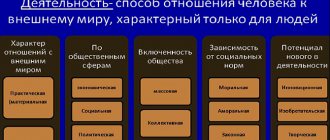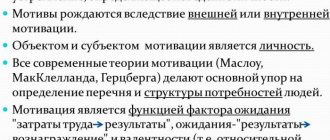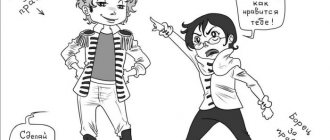The concept of activity in psychology
The concept of “activity”, along with such concepts as “consciousness”, “personality”, “communication”, is one of the fundamental ones in psychological science. Activity is a dynamic system of interaction between a subject and the world. In the process of this interaction, a mental image arises and is embodied in an object, as well as the subject’s realization of his relationship with the surrounding reality. Activity is a form of human activity, i.e. the form of its interaction with the environment. But activity is not just any activity, activity is human activity aimed at achieving consciously set goals and associated with the creation of socially significant values or the development of social experience (Shadrikov’s definition).
Afterword
Conscious purposeful activity is the difference between people and animals. In its process, a person creates objects of material and spiritual culture, transforms his abilities, ensures progress (although sometimes regression) of society, influences nature (preserves or destroys).
Any activity is a creative way beyond the natural, work on oneself and the world. Man not only consumes, but also creates. With her help he influences his life.
Thanks to it, the mental development of the individual is carried out. However, at the same time, mental processes (perception, attention, imagination, memory, thinking, speech) act as components and even separate types of activity.
Modern psychological science is based on such basic concepts as “personality”, “consciousness”, “activity”, “communication”. Often the concept of activity in psychology is interpreted as a unique form of the subject’s relationship to the world around him. Moreover, this attitude is conscious, aimed at its development and transformation to the extent that it seems appropriate to the individual. The role of consciousness depends on the type of activity - in scientific, work or play, its psychological component is different.
Activity is recognized as the basis for personality formation.
Articles on the topic
- The tasks of modern psychology in the field of development and formation of human personality
- Problems of modern psychology - science is plunging into crisis
- Methodological principles of psychology: current methods that allow you to study everything
- Corporate relations in modern society
A purposeful attitude towards the world is realized in the following types: cognitive, evaluative, spiritual or material, reproductive, creative and many others.
Psychological characteristics of activity
The activity has the following features unique to it:
- Subject : each activity has its own subject. The object of activity appears in two ways: primarily - in its independent existence, as subordinating and transforming the activity of the subject, secondly - as an image of the object, a product of the mental reflection of its properties, which is carried out as a result of the activity of the subject and cannot be realized otherwise.
- Awareness and purposefulness . Activity is regulated not by human needs, but by a perceived goal as an ideal image of a future result. The goal is a system-forming factor of activity, i.e., the main criterion for determining its content, structure and dynamics. This is the most important difference between activity and other forms of human activity.
- Social conditioning . For all its originality, human activity is a system included in the system of social relations. Outside of these relationships, human activity does not exist. A person finds in society not just external conditions to which he must adapt his activities - social conditions themselves carry within themselves the motives and goals of his activities, its means and methods. In essence, society produces the activities of the individuals who form it.
- Systematicity . Activity appears not as a simple sum of its components, but as their organized integrity. It is important to note that activity as an integrity has properties that neither its individual components nor their simple sum have.
Subject and principles
Behaviorism is in psychology, briefly and clearly.
Activity is always aimed at something or someone, i.e. it cannot be pointless. Scientists identify two main principles:
- Functionality - a person relies on already developed mental elements and mobilizes forces to achieve a goal.
- Systematicity - activity always has a certain structure, it is influenced by the individual qualities of the individual.
Psychological activity is of great importance, as it makes it possible to understand the peculiarities of the functioning of the human personality.
Psychological structure of activity
The systematic organization of activity determines the existence of two main plans for its psychological analysis - external (objectively effective) and internal (actually psychological). Each activity has the following structure:
- The motive of activity is the reason that prompts a person to activity and gives this activity a certain direction.
- The purpose of the activity is the image of the required future, the expected result of the activity. The goal is formed on the basis of the motive of the activity.
- The subject of activity is that object of the external environment to change which human activity is aimed. However, the subject of activity can be not only material, but also ideal (mental activity).
- Means and conditions of activity . The means include tools and psychophysiological resources of the body. Working conditions include not only the physical characteristics of the environment, but also the psychological states of a person.
- The product of activity is the result of activity. A product can be direct or by-product: a direct product is an objective result of an activity, a change in the external environment created in the process of activity; a by-product is a subjective result of an activity, a change in a person’s inner world (satisfaction, acquired knowledge, skills, etc.).
Hierarchical structure of activity (Leontiev): activity is carried out with the help of actions, and actions, in turn, with the help of operations (activity is a chain of actions, and actions are chains of operations).
- Activity.
- Action is an element of activity in the process of which a specific, not decomposed into simpler, conscious goal is achieved. Action is a relatively independent and completed act of activity. Actions are aimed at achieving the goals of the activity and act as the unit of analysis of activity. In the process of exercises, the structure of actions changes, they become “collapsed”, more economical and faster to implement, turning into skills.
- Operations are ways of carrying out actions under certain conditions. Operations are aimed at solving the tasks of the activity and are determined by the means and conditions of the activity. As a rule, operations are automated and unconscious in nature.
Activities
Human activity is not only extremely complex in content and structure, but also extremely diverse in its general varieties and specific manifestations. It is traditionally accepted that the main division of activity into its types is differentiation into work, educational and play activities:
- Labor activity is the process of actively changing objects of nature, the material and spiritual life of society in order to satisfy human needs and create various values. Labor activity presupposes the receipt of some socially significant product, result, in contrast to educational and gaming activities, where this result is not socially, but individually significant and consists in the subject’s mastering of socially developed experience, knowledge, etc. for subsequent work activities.
- Teaching acts as a type of activity, the purpose of which is to acquire knowledge, skills and abilities by a person. Teaching can be organized and carried out in special educational institutions. It may not be organized and occur along the way, in other activities as a by-product, additional result. In adults, learning can take on the character of self-education. The peculiarities of educational activity are that it directly serves as a means of psychological development of the individual.
- A game is a special type of activity in which typical ways of action and interaction of people have been historically established. The result of gaming activity is not the production of any material or ideal product. However, games are of great importance in people's lives. The inclusion of a child in play activities provides the opportunity to master the social experience accumulated by humanity, as well as the cognitive, personal and moral development of the child. Of particular importance is role-playing play, during which the child takes on the roles of adults and acts with objects in accordance with the assigned meanings. The mechanism of learning social roles through role-playing games provides the opportunity for socialization of the individual. A specific feature of gaming activity is that its main motive is the process of activity itself, and not its result.
These types of activities have different significance for human development at different stages of ontogenesis. The activity, the implementation of which determines the emergence and formation of the main psychological new formations of a person at a certain stage of ontogenetic development, is called leading activity .
What it is
Activity is a form of human activity aimed at cognition, transformation of the surrounding world, oneself and the conditions of one’s existence. This is what distinguishes man from animals and emphasizes the social in human nature.
- Activities are not limited to meeting needs.
- It is determined by the goals and requirements of society.
- Actions are associated with the development of personality and human consciousness (including self-awareness).
- This is a consciously regulated process of human interaction with the world.
In activity, a person acts as a creator, creator. In its process, the following develop:
- intellectual abilities of the individual;
- creative imagination;
- worldview;
- system of ideals and values;
- emotional and aesthetic attitude to the world.
As a member of society, a person is valuable when he leads an active working and social life, commits actions and bears responsibility for them.
Subject of activity
Activity is always objectified. The subject is what it is aimed at. It can exist independently or be created in the process of the activity itself.
Operating principles
The activity is based on the principle of functionality and the principle of consistency.
- The first involves relying on already developed mental elements that are mobilized to achieve a goal.
- The principle of systematicity presupposes the inclusion of individual personality traits, on the basis of which several blocks in the structure can be identified.
Activity structure
Six blocks can be distinguished. Each of the elements is interconnected with others, interpenetrating.
Motives
This is where needs come into play. A motive is an objectified need. The desire to satisfy a need, that is, to obtain a specific item, encourages activity. Activity is impossible without motive.
Goals
Main element. It has two forms of manifestation:
- as a result represented by a person;
- as the desired level of achievement.
Program
A person decides what and how he should do, that is, it is a choice of methods and means, an assessment of his own resources. The work includes the cognitive, motivational, and executive spheres.
Information base
Its effectiveness depends on the adequacy and completeness of information about the conditions of activity.
Making decisions
One is selected from the alternative options, mastered, and rules and criteria for achieving the goal are developed.
Personal qualities that are significant for activities
These are character traits, abilities, inclinations and other individual characteristics that will help you achieve your goal.
Activity Components
Activity always has an internal plan and an external manifestation, between which there is an inextricable connection. From external operations with objects (objective thinking), information, transformed by the psyche, turns into internal images, ideals (imaginative thinking). The process of such a transition is called internalization.
The reverse action (creating something materially through internal representations) is exteriorization.
Action is a tool to achieve a goal
Action is a part of an activity aimed at achieving an intermediate result in specific conditions. Consists of operations - methods of execution according to conditions.
Physical actions
These are external, motor actions with objects that consist of movements.
Intelligent Actions
Internal mental actions with images and concepts based on external actions with objects.
Psyche – regulator of activity
The reflection of the world by the psyche occurs consciously, that is, in the process of actions a person:
- is aware (partially or fully) of the purpose of his actions;
- represents the result;
- perceives and evaluates the conditions in which one has to act;
- builds a step-by-step plan, an algorithm of operations;
- makes volitional efforts;
- observes the process;
- experiences successes and failures.










